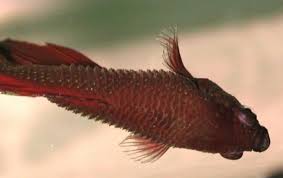What Is Betta Fish Dropsy & How To Treat It
Dropsy in betta fish is not a disease but a symptom of a deeper internal problem. It typically signals organ failure, a bacterial infection, or another systemic issue. The most recognizable sign of dropsy is raised scales that give the fish a pinecone-like appearance due to internal swelling and fluid retention.

credit: betta fish forum: pineconing of the fins
Quick Summary: Dropsy in Betta Fish
- Cause: Bacterial infection, kidney failure, poor water quality
- Symptoms: Bloating, pinecone scales, lethargy, appetite loss
- Treatment: Isolate fish in a quarantine tank, aquarium Epsom salt, Kanaplex or Maracyn Two
- Outlook: Often fatal if not caught early
- Prevention: Clean tank, check for stable water using a testing kit, and look at the food you’re feeding them — use high-quality betta food
Early Symptoms of Dropsy in Bettas
Catching dropsy early is critical. Here are the signs to watch for:
- Swollen belly that affects the whole body, not just the stomach area
- Pinecone-like scales when viewed from above
- Lethargy and lack of movement
- Loss of appetite, even when offered favorite foods
- Color fading or a pale appearance
- Bottom-sitting or floating sideways
- Gasping at the surface for air
Tip: Compare your betta to images of healthy fish. A side-by-side comparison often reveals changes more clearly.
What Causes Dropsy in Betta Fish?
Dropsy is most often caused by a gram-negative bacterial infection, but many contributing factors can trigger it:
- Kidney or liver failure that prevents fluid regulation
- Poor water quality, such as high ammonia or nitrite levels
- Sudden temperature changes or cold water
- Overfeeding and poor diet
- Stress from overcrowding or aggressive tank mates
- Old age, which makes bettas more susceptible to internal failures
How to Treat Dropsy in Betta Fish
Step-by-Step Treatment:
- Move your betta to a hospital tank with clean, warm water (78–80°F).
- Lower the water level to help the fish reach the surface easily.
- Add an air stone to improve oxygenation.
- Add Epsom salt (0.5 teaspoons per gallon). Make sure it’s fully dissolved.
- Administer antibiotics:
- Kanaplex (kanamycin-based) or
- Maracyn Two (minocycline-based)
- Follow the dosage instructions strictly. Don’t stop treatment early.
- Keep your main tank separate. Do not return hospital water to it afterward.
Note: If your betta is no longer eating, choose medications that are absorbed through the skin and gills.
Is Dropsy in Bettas Curable?
Dropsy is often fatal in advanced cases. If caught early, treatment may work. Many fish do not survive, but some recover with aggressive early care.
In cases where your fish is severely bloated, not responding to treatment, and suffering, humane euthanasia may be the most compassionate choice.
How to Prevent Dropsy in Betta Fish
Prevention is key:
- Keep your tank clean and cycled – use a testing kit
- Maintain a steady tropical temperature with a heater (78°F)
- Feed high-quality food in small portions
- Test water regularly for ammonia, nitrite, and nitrate
- Quarantine new tank mates or live foods before introducing them
Recommended Medications for Dropsy
| Medication | Brand | Active Ingredient | Where to Buy |
|---|---|---|---|
| Kanaplex | Seachem | Kanamycin | Amazon link |
| Maracyn Two | Fritz Aquatics | Minocycline | Amazon link |
These antibiotics are known to help treat internal bacterial infections responsible for dropsy. Use only as directed.
Click here if your betta has stopped eating altogether or if the betta is floating near the top as it might be swim bladder. We also have a full list of diseases here.
